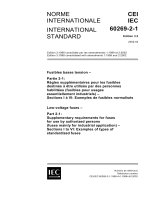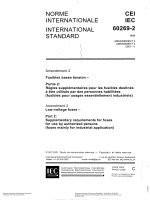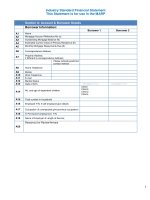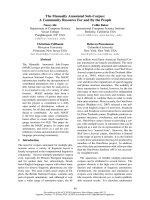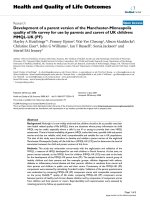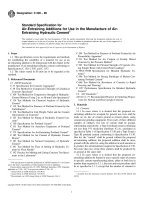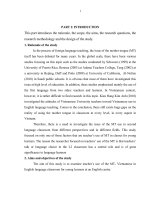Manual for use by the
Bạn đang xem bản rút gọn của tài liệu. Xem và tải ngay bản đầy đủ của tài liệu tại đây (7.2 MB, 504 trang )
TABLE OF CONTENTS
Manual for use by the maritime mobile and
maritime mobile-satellite services
Page
3
FOREWORD ...........................................................................................................
PART A
Extracts from the Constitution and Convention of
the International Telecommunication Union
Constitution
(CS) of the International
Telecommunication
Union
CHAPTER VI - General Provisions Relating to Telecommunications
ARTICLE 33
The Right of the Public to Use the International Telecommunication
Service ......................................................................................................
7
ARTICLE 34
Stoppage of Telecommunications
7
ARTICLE 35
Suspension of Services .............................................................................
7
ARTICLE 36
Responsibility ...........................................................................................
8
ARTICLE 37
Secrecy of Telecommunications ...............................................................
8
ARTICLE 39
Notification of Infringements ...................................................................
8
ARTICLE 40
Priority of Telecommunications
8
ARTICLE 41
Priority of Government Telecommunications ..........................................
............................................................
Concerning Safety of Life ....................
9
CHAPTER VII - Special Provisions for Radio
ARTICLE 45
Harmful Interference ................................................................................
9
ARTICLE 46
Distress Calls and Messages .....................................................................
9
ARTICLE 47
False or Deceptive Distress, Urgency, Safety or Identification Signals ...
10
Definition of Certain Terms Used in this Constitution, the Convention and
the Administrative Regulations of the International Telecommunication
Union
............................................................................................................
11
ANNEX
iv
Page
Convention (CV) of the International Telecommunication Union
CHAPTER
V - Various Provisions Related to the Operation of Telecommunication Services
ARTICLE 36
Charges and Free Services .......................................................................
12
ARTICLE 38
Monetary Unit ..........................................................................................
12
ARTICLE 39
Intercommunication ..................................................................................
12
ARTICLE 40
Secret Language .......................................................................................
13
ANNEX
Definition of Certain Tenns Used in this Convention and the Administrative
Regulations of the International Telecommunication Union ...........................
14
PART B
Extracts from the Radio Regulations (RR)
(Edition of 200 1)
SECTION
ARTICLE
I - Articles (Extracts)
1
Tenns and definitions ..............................................................................
23
ARTICLE 2
N omenclature ..........................................................................................
42
ARTICLE 3
Technical characteristics of stations ........................................................
44
ARTICLE 4
Assignment and use of frequencies .........................................................
46
ARTICLE 5
Frequency allocations ..............................................................................
49
ARTICLE
15
Interferences ............................................................................................
52
ARTICLE
17
Secrecy ....................................................................................................
57
ARTICLE
18
Licences ...................................................................................................
58
ARTICLE
19
Identification of stations ..........................................................................
60
ARTICLE 20
Service documents ...................................................................................
73
ARTICLE 28
Radiodetennination
75
services ...................................................................
v
Page
ARTICLE 30
General provisions ...................................................................................
78
ARTICLE 31
Frequencies for the global maritime distress and safety system
(GMDSS) .......................................................................
,.........................
81
Operational procedures for distress and safety communications in the
global maritime distress and safety system (GMDSS) ............................
83
Operational procedures for urgency and safety communications in the
global maritime distress and safety system (GMDSS) ............................
92
Alerting signals in the global maritime distress and safety system
(GMDSS) .................................................................................................
97
ARTICLE 46
Authority of the master ............................................................................
98
ARTICLE 47
Operator's certificates ..............................................................................
99
ARTICLE 48
PersonneL .................................................................................................
104
ARTICLE 49
Inspection of stations ...............................................................................
105
ARTICLE 50
Working hours of stations ........................................................................
106
ARTICLE 51
Conditions to be observed in the maritime services ................................
107
ARTICLE 52
Special rules relating to the use of frequencies .......................................
113
ARTICLE 53
Order of priority of communications .......................................................
140
ARTICLE 54
Selective calling .......................................................................................
141
ARTICLE 55
Morse radiotelegraphy .............................................................................
142
ARTICLE 56
Narrow-band direct-printing telegraphy ..................................................
143
ARTICLE 57
Radiotelephony ........................................................................................
144
ARTICLE 58
Charging and accounting for maritime radiocommunications
................
145
ARTICLE 32
ARTICLE 33
ARTICLE
34
SECTION II - Appendices (Extracts)
APPENDIX
1
Classification of emissions and necessary bandwidths ........................
149
APPENDIX
2
Table of transmitter frequency tolerances ............................................
154
APPENDIX
3
(WRC-2000) Table of maximum permitted spurious emission power
levels ....................................................................................................
160
APPENDIX
9
Report of an irregularity or infringement.. ...........................................
168
APPENDIX
10
Report of harmful interference .............................................................
171
vi
Page
APPENDIX
12
Special rules applicable to radiobeacons .............................................
173
APPENDIX
13
(WRC-2000) Distress and safety communications (non-GMDSS) .....
174
APPENDIX
14
Phonetic alphabet and figure code .......................................................
204
APPENDIX
15
Frequencies for distress and safety communications for the Global
Maritime Distress and Safety System (GMDSS) ................................
206
Documents with which stations on board ships and aircraft shall be
provided ...............................................................................................
210
(WRC-2000) Frequencies and channelling arrangements in the
high-frequency bands for the maritime mobile service .......................
213
(WRC-2000) Table of transmitting frequencies in the VHF maritime
mobile band .........................................................................................
242
(WRC-2000) Table of allocation of international call sign series .......
245
APPENDIX
16
APPENDIX
17
APPENDIX
APPENDIX
18
42
SECTION III - Resolutions (Extracts)
RESOLUTION
RESOLUTION
RESOLUTION
RESOLUTION
RESOLUTION
RESOLUTION
18
205
312
331
340
343
(Mob-83) Relating to the procedure for identifying and
announcing the position of ships and aircraft of States not parties
to an armed conflict. .......................................................................
249
(Rev.Mob-87) Protection of the band 406-406.1 MHz allocated
to the mobile-satellite service ........................................................
251
(Rev.WRC-97) Calling procedures for HF AlA and A1B Morse
telegraphy ......................................................................................
253
(Rev.WRC-97) Transition to the Global Maritime Distress and
Safety System (GMDSS) and continuation of the distress and
safety provisions in Appendix 13...................................................
255
(WRC-97) Need for additional search and rescue information
in databases ....................................................................................
258
(WRC-97) Maritime certification for personnel of ship stations
and ship earth stations for which a radio installation is not
compulsory .....................................................................................
260
vii
Page
RESOLUTION
349
(WRC-97) Operational procedures for cancelling false distress
alerts in the Global Maritime Distress and Safety System .............
263
RESOLUTION
350
(WRC-2000) Study on interference caused to the distress and
safety frequencies 12 290 kHz and 16 420 kHz by routine calling
266
incorporated
by
SECTION IV -
Recommendations
ITU-R
reference (Extracts)
Rec. ITU-R M.489-2
Technical characteristics of VHF radiotelephone equipment
operating in the maritime mobile service in channels spaced by
25 kHz ............................................... ,............................................
271
Rec. ITU-R M.492-6
Operational procedures for the use of direct-printing telegraph
equipment in the maritime mobile service .....................................
273
Rec. ITU-R M.54l-8
Operational procedures for the use of digital selective-calling
equipment in the maritime mobile service .....................................
282
Rec. ITU-R SM.1138
Determination of necessary bandwidths including examples for
their calculation and associated examples for the designation of
emIssIons ................................... ···················································· .
314
Rec. ITU-R M.1169
Hours of service of ship stations ...........................................
·........
322
Rec. ITU-R M.ll70
Morse telegraphy procedures in the maritime mobile service .......
327
Rec. ITU-RM.1171
Radiotelephony procedures in the maritime mobile service ..........
334
Rec.ITU-RM.1172
Miscellaneous abbreviations and signals to be used for
radiocommunications in the maritime mobile service ...................
343
Rec.ITU-RM.1173
Technical characteristics of single-sideband transmitters used in
the maritime mobile service for radiotelephony in the bands
between 1 606.5 kHz (1 605 kHz region 2) and 4000 kHz and
between 4000 kHz and 27 500 kHz ..............................................
376
Technical characteristics of equipment used for on-board vessel
communications in the bands between 450 and 470 MHz .............
378
and
······
380
Rec. ITU-R M.1174-l
Rec. ITU-R M.1175
for radiotelegraph
equipment
receIvmg
Automatic
radiotelephone alarm signals ....................................................
viii
Page
PART C
Extracts from other ITU-R Recommendations
(M Series)
Rec. ITU-R M.493-1O Digital selective-calling system for use in the maritime mobile
servIce ............................................................................................
383
Rec. ITU-R M.585-2
Assignment and use of maritime mobile service identities ............
407
Rec. ITU-R M.689-2
system with
International
maritime VHF radiotelephone
automatic facilities based on DSC signalling formaL ...................
410
PART D
Extracts from the International Telecommunication Regulations
(Melbourne, 1988)
Purpose and Scope of the Regulations ....................................................
421
ARTICLE 2
Definitions ...............................................................................................
421
ARTICLE 3
International Network ..............................................................................
422
ARTICLE 4
International Telecommunication
Services .............................................
422
ARTICLE 5
Safety of Life and Priority of Telecommunications ................................
423
ARTICLE 6
Charging and Accounting ........................................................................
423
ARTICLE 7
Suspension of Services ............................................................................
424
ARTICLE 9
Special Arrangements ..............................................................................
424
ARTICLE
Final Provisions .......................................................................................
425
ARTICLE
1
10
APPENDIX
I
General Provisions Concerning Accounting ...........................................
426
APPENDIX
2
Additional Provisions Relating to Maritime Telecommunications .........
429
ix
Page
PART E
Extracts from ITU- T Recommendations
ITU-T Rec. D.90
Charging, billing, international accounting and settlement in the
maritime mobile service .............................................................. '"
435
Instructions for operators on the operator-assisted international
telephone service ............................................................................
448
Operational provisions for the international public telegram
servIce .............................................................................................
465
ITU-T Rec. F.60
Operational provisions for the international telex service .............
495
ITU-T Rec. F.lIO
Operational provision for the maritime mobile service .................
501
ITU-T Rec. F.120
Ship station identification for VHFIUHF and maritime mobilesatellite services ..............................................................................
518
ITU-T Rec. E.l41
ITU-T Rec. F.1
PART F
Extracts from the Preface to List VIlA
(Edition of 200 1)
TABLE I
Table of Allocation of International Call Sign Series (Appendix 42 to
the Radio Regulations) ...............................................................................
527
TABLE 2
Table of Allocation of Blocks of Coast Station Identification Numbers '"
530
TABLE 3
Table of Allocation of Blocks of Selective Call Numbers for Ship
Stations and Selective Call Numbers for Groups of Ship Stations .............
531
Table of Allocation of Maritime Identification Digits ...............................
534
TABLE 4
3
Foreword
1.
The 2001 edition of the Manual for use by the Maritime Mobile and Maritime
Mobile-Satellite Services is published in accordance with Article 20 (No. 20.14) of the Radio
Regulations, and results from the revision of texts contained in Parts A, B, C, E and F of the
Manual extracted from other ITU publications. The contents of each Part of the Manual are listed
below and supplementary information is given to help and inform its users.
2.
This Manual, which contains provisions designed to be of use to operators in the
maritime mobile and maritime mobile-satellite services, is divided into the following six main
Parts:
Part A, contains extracts
Telecommunication Union.
from
the
Constitution
and
Convention
of the
International
Part B, contains extracts from the Radio Regulations (RR) (Edition of 2001). This Part is divided
into four Sections:
Section I
-
Articles (Extracts).
Section II
-
Appendices (Extracts).
Section III
-
Resolutions (Extracts).
Section IV
-
ITU-R Recommendations incorporated by reference (Extracts).
Part C, contains extracts from other ITU-R Recommendations (M Series):
-
Recommendation ITU-R M.493-10: Digital selective-calling system for use in the maritime
mobile service.
-
Recommendation
identities.
ITU-R M.585-2:
Assignment
and use of maritime
mobile
service
Recommendation ITU-R M.689-2: International maritime VHF radiotelephone system with
automatic facilities based on DSC signalling format.
Part D, contains extracts from the International Telecommunications
1998).
Regulations (Melbourne,
Part E, contains extracts from ITU- T Recommendations:
-
ITU- T Recommendation D.90: Charging, billing, international accounting and settlement in
the maritime mobile service.
-
ITU-T Recommendation E.141: Instructions for operators on the operator-assisted
national telephone service.
-
ITU-T Recommendation
servIce.
inter-
F.1: Operational provisions for the international public telegram
ITU-T Recommendation F.60: Operational provisions for the international telex service.
4
-
ITU- T Recommendation F.II 0: Operational provisions for the maritime mobile service.
ITU-T Recommendation
mobile-satellite services
F.120: Ship station identification
for VHFIUHF and maritime
Part F, contains extracts from the Preface to List VIlA (Edition of2001).
3
Listed below are the pages of the different parts of the Manual which contain
definitions:
-
Part A: pages 11 and 14
-
Part B, Section I: pages 23-41
-
Part B, Section IV: page 283
-
Part D: pages 421 and 422
-
Part E: pages 435, 448-450, 501, 512 and 516.
This Part A contains extracts from the Constitution and Convention of the International
Telecommunication Union adopted by the Additional Plenipotentiary Conference
(Geneva, 1992) as amended by the Plenipotentiary Conference (Kyoto, 1994), also including
amendments, adopted by the Plenipotentiary Conference (Minneapolis, 1998) which entered into
force on 1 January 2000 (in accordance with Part II of the Final Acts of the Plenipotentiary
Conference of the International Telecommunication Union (Minneapolis, 1998)).
CS
7
CONSTITUTION (CS) OF THE INTERNATIONAL
TELECOMMUNICATION UNION
CHAPTER VI
General Provisions Relating to Telecommunications
ARTICLE 33 (CS)
The Right of the Public to Use the International
Telecommunication Service
179
PP-98
Member States recognize the right of the public to correspond by means of
the international service of public correspondence. The services, the charges and the
safeguards shall be the same for all users in each category of correspondence without
any priority or preference.
ARTICLE 34 (CS)
Stoppage of Telecommunications
180
PP-98
Member States reserve the right to stop, in accordance with their national law,
1
the transmission of any private telegram which may appear dangerous to the security
of the State or contrary to its laws, to public order or to decency, provided that they
immediately notify the office of origin of the stoppage of any such telegram or any
part thereof, except when such notification may appear dangerous to the security of
the State.
181
PP-98
Member States also reserve the right to cut off, in accordance with their
2
national law, any other private telecommunications which may appear dangerous to
the security of the State or contrary to its laws, to public order or to decency.
ARTICLE 35 (CS)
Suspension of Services
182
PP-98
Each Member State reserves the right to suspend the international
telecommunication service, either generally or only for certain relations and/or for
certain kinds of correspondence, outgoing, incoming or in transit, provided that it
immediately notifies such action to each of the other Member States through the
Secretary -General.
8
CS
ARTICLE 36 (CS)
Responsibility
183
PP-98
Member States accept no responsibility towards users of the international
telecommunication services, particularly as regards claims for damages.
ARTICLE 37 (CS)
Secrecy of Telecommunications
184
PP-98
185
I
Member States agree to take all possible measures, compatible with the
system of telecommunication used, with a view to ensuring the secrecy of
international correspondence.
2
Nevertheless, they reserve the right to communicate such correspondence to
the competent authorities in order to ensure the application of their national laws or
the execution of international conventions to which they are parties.
ARTICLE 39 (CS)
Notification of Infringements
190
PP-98
In order to facilitate the application of the provisions of Article 6 of this
Constitution, Member States undertake to inform and, as appropriate, assist one
another with regard to infringements of the provisions of this Constitution, of the
Convention and of the Administrative Regulations.
ARTICLE 40 (CS)
Priority of Telecommunications Concerning
Safety of Life
191
International telecommunication services must give absolute priority to all
telecommunications concerning safety of life at sea, on land, in the air or in outer
space, as well as to epidemiological telecommunications of exceptional urgency of
the World Health Organization.
CS
9
ARTICLE 41 (CS)
Priority of Government Telecommunications
192
Subject to the provisions of Articles 40 and 46 of this Constitution,
government telecommunications (see Annex to this Constitution, No. 10 14) shall
enjoy priority over other telecommunications to the extent practicable upon specific
request by the originator.
CHAPTER VII
Special Provisions for Radio
ARTICLE 45 (CS)
lIarmfulInterference
197
PP-98
198
PP-98
199
PP-98
1
All stations, whatever their purpose, must be established and operated in such
a manner as not to cause harmful interference to the radio services or
communications of other Member States or of recognized operating agencies, or of
other duly authorized operating agencies which carry on a radio service, and which
operate in accordance with the provisions of the Radio Regulations.
2
Each Member State undertakes to require the operating agencies which it
recognizes and the other operating agencies duly authorized for this purpose to
observe the provisions of No. 197 above.
3
Further, the Member States recognize the necessity of taking all practicable
steps to prevent the operation of electrical apparatus and installations of all kinds
from causing harmful interference to the radio services or communications
mentioned in No. 197 above.
ARTICLE 46 (CS)
Distress Calls and Messages
200
Radio stations shall be obliged to accept, with absolute priority, distress calls
and messages regardless of their origin, to reply in the same manner to such
messages, and immediately to take such action in regard thereto as may be required.
10
CS
ARTICLE 47 (CS)
False or Deceptive Distress, Urgency, Safety
or Identification Signals
201
PP-98
Member States agree to take the steps required to prevent the transmission or
circulation of false or deceptive distress, urgency, safety or identification signals, and
to collaborate in locating and identifying stations under their jurisdiction transmitting
such signals.
CS
11
ANNEX
Definition of Certain Terms Used in this Constitution,
the Convention and the Administrative Regulations
of the International Telecommunication Union
1001
For the purpose of the above instruments of the Union, the following terms
shall have the meanings defined below:
1001A
Member State: A State which is considered to be a Member of
the International Telecommunication Union in application of Article 2 of this
Constitution.
PP-98
1001H
PP-98
Sector Member: An entity or organization authorized in accordance with
Article 19 of the Convention to participate in the activities of a Sector.
1003
Harmful Interference: Interference which endangers the functioning of a
radionavigation service or of other safety services or seriously degrades, obstructs or
repeatedly interrupts a radiocommunication service operating in accordance with the
Radio Regulations.
1007
Operating Agency: Any individual, company, corporation or governmental
agency which operates a telecommunication installation intended for an international
telecommunication service or capable of causing harmful interference with such a
service.
1008
Recognized Operating Agency: Any operating agency, as defined above,
which operates a public correspondence or broadcasting service and upon which the
obligations provided for in Article 6 of this Constitution are imposed by the Member
State in whose territory the head office of the agency is situated, or by the Member
State which has authorized this operating agency to establish and operate a telecommunication service on its territory.
PP-98
1011
International
Telecommunication
Service: The offering of a telecommunication capability between telecommunication offices or stations of any
nature that are in or belong to different countries.
1014
Government Telecommunications:
Telecommunications
-
Head of State;
-
Head of government or members of a government;
-
Commanders-in-Chief
-
diplomatic or consular agents;
-
the Secretary-General of the United Nations; Heads of the principal organs of
the United Nations;
-
the International Court of Justice,
of military forces, land, sea or air;
or replies to government telecommunications
1015
originating with any:
mentioned above.
Private Telegrams: Telegrams other than government or service telegrams.
12
CV
CONVENTION (CV) OF THE INTERNATIONAL
TELECOMMUNICATION UNION
CHAPTER V
Various Provisions Related to the Operation
of Telecommunication Services
ARTICLE 36 (CY)
Charges and Free Services
496
The provisions regarding charges for telecommunications and the various
cases in which free services are accorded are set forth in the Administrative
Regulations.
ARTICLE 38 (CY)
Monetary Unit
500
PP-98
In the absence of special arrangements concluded between Member States,
the monetary unit to be used in the composition of accounting rates for international
telecommunication services and in the establishment of international accounts shall
be:
either the monetary unit of the International Monetary Fund
-
or the gold franc,
both as defined in the Administrative Regulations. The provisions for application are
contained in Appendix I to the International Telecommunication Regulations.
ARTICLE 39 (CY)
Intercommunication
501
I
Stations performing radiocommunication in the mobile service shall be
bound, within the limits of their normal employment, to exchange radiocommunications reciprocally without distinction as to the radio system adopted by them.
CV
13
502
2
Nevertheless, in order not to impede scientific progress, the provisions of
No. 501 above shall not prevent the use of a radio system incapable of
communicating with other systems, provided that such incapacity is due to the
specific nature of such system and is not the result of devices adopted solely with
the object of preventing intercommunication.
503
3
Notwithstanding the provisions of No. 501 above, a station may be assigned
to a restricted international service of telecommunication, determined by the
purpose of such service, or by other circumstances independent of the system used.
ARTICLE 40 (CY)
Secret Language
505
PP-98
506
PP-98
2
Private telegrams in secret language may be admitted between all Member
States with the exception of those which have previously notified, through the
Secretary-General, that they do not admit this language for that category of
correspondence.
3
Member States which do not admit private telegrams in secret language
originating in or destined for their own territory must let them pass in transit, except
in the case of suspension of service provided for in Article 35 of the Constitution.
14
CV
ANNEX
Definition of Certain Terms Used in this Convention and
the Administrative Regulations of the International
Telecommunication Union
For the purpose of the above instruments of the Union, the following terms
shall have the meanings defined below:
1006
Service Telecommunication:
A telecommunication that relates to public
international telecommunications and that is exchanged among the following:
-
administrations,
-
recognized operating agencies, and
-
the Chairman of the Council, the Secretary-General, the Deputy SecretaryGeneral, the Directors of the Bureaux, the members of the Radio Regulations
Board, and other representatives or authorized officials of the Union,
including those working on official matters outside the seat of the Union.
PART B
Extracts from the Radio Regulations (RR)
(Edition of 200 1)
SECTION I
-
ARTICLES (Volume I ofthe RR)
SECTION II
-
APPENDICES (Volume 2 of the RR)
SECTION III - RESOLUTIONS (Volume 3 ofthe RR)
SECTION IV -
ITU-R RECOMMENDA TIONS INCORPORATED
(Volume 4 of the RR)
BY REFERENCE
Note by the Secretariat
This revision of the Radio Regulations, complementing the Constitution and the Convention of
the International Telecommunication Union, incorporates the decisions of the World Radiocommunication Conferences of 1995 (WRC-95), of 1997 (WRC-97) and of 2000 (WRC-2000). The
majority of the provisions of these Regulations shall enter into force as from 1 January 2002; the
remaining provisions shall apply as from the special dates of application indicated in Article 59
of the revised Radio Regulations.
In preparing the Radio Regulations, edition of 2001, the Secretariat corrected the typographical
errors that were drawn to the attention ofWRC-2000 and which were approved by WRC-2000.
In accordance with the decisions of WRC-2000, this edition uses a new numbering scheme,
which consists, inter alia, in abolishing the prefix "8" in front of the provision numbers, Article
numbers and Appendix numbers. The numbering scheme is identical to the previous edition of
the Radio Regulations, but without the prefix "8" in front of the provision numbers, Article
numbers and Appendix numbers. In some cases, however, the prefix "8" was maintained due to
historical reasons or for referential purposes.
With respect to Article numbers, this edition follows the standard sequential numbering. The
Article numbers are not followed by any abbreviation (such as "WRC-97" or "WRC-2000").
Consequently, any reference to an Article, in any of the provisions of these Radio Regulations
(e.g. in No. 13.1 of Article 13), in the texts of the Appendices as contained in Volume 2 of this
edition (e.g. in § 1 of Appendix 2), in the texts of the Resolutions included in Volume 3 of this
edition (e.g. in Resolution 1(Rev.WRC-97», and in the texts of the Recommendations included
in Volume 3 of this edition (e.g. in Recommendation 8), is considered as a reference to the text
of the concerned Article which appears in this edition, unless otherwise specified.
With respect to provision numbers in Articles, this edition continues to use composite numbers
indicating the number of the Article and the provision number within that Article (e.g. No. 9.2B
means provision No. 2B of Article 9). The abbreviation "(WRC-2000)" or "(WRC-97)" at the
end of such a provision means that the relevant provision was modified or added by WRC-2000
or by WRC-97, as applicable. The absence of an abbreviation at the end of the provision means
that the provision is identical with the provision of the simplified Radio Regulations as approved
by WRC-95, and whose complete text was contained in Document 2 of WRC-97. However, as
some of the Resolutions call for the application of a provision of the Radio Regulations, this
edition of the Radio Regulations and the corresponding Resolutions contains references to three
differents sets of provision numbers:
-
provision numbers that are not preceded by the letter "8" and which follow the new
numbering scheme comprising a composite number indicating the number of the Article
and the provision number within that Article; the quoted provision number corresponds to
its version in the current edition;
-
provision numbers that are not preceded by the letter "8" and which follow the old
numbering scheme of sequential numbers. Their quotation was maintained in those cases
where their application is still relevant. To avoid any ambiguity, these provisions are
normally followed by the additional explication that they refer to provisions of the Radio
Regulations, edition of ] 990, revised in 1994;
-
provision numbers that are preceded by the letter "8"; the quoted provision number
corresponds to the provisions of the Radio Regulations, edition of 1998, unless otherwise
specified. These quotations were maintained only in those cases where justified, either for
historical reasons, or for reference purposes (i.e., when the quoted provision is different
from the new provision). When the reference was maintained for historical reasons, and
where applicable, an appropriate note by the Secretariat has been added to indicate the
provision number corresponding to the new numbering scheme.
With respect to Appendix numbers, this edition follows the standard sequential numbering,
with the addition of the appropriate abbreviation after the Appendix number (such as
"(WRC-97)" or "(WRC-2000)"), where applicable. As a rule, any reference to an Appendix, in
any of the provisions of these Radio Regulations, in the texts of the Appendices as contained in
Volume 2 of this edition, in the texts of the Resolutions and of the Recommendations included in
Volume 3 of this edition, is presented in the standard manner (e.g. "Appendix 30 (WRC-2000)")
if not explicitly described in the text (e.g. Appendix 4 as modified by WRC-2000). Simple
references to Appendix numbers, where the number is preceded by the letter "8" but without an
abbreviation at the end (such as "Appendix 830"), correspond to the version of the concerned
Appendix in the 1998 edition of the Radio Regulations, unless otherwise specified. Simple
references to Appendix numbers, where the number is not preceded by the letter "8" and without
an abbreviation at the end (such as "Appendix 19"), correspond to the current version of the
concerned Appendix, as it appears in this edition of the Radio Regulations. In the texts of
Appendices that were partially modified by WRC-2000, the provisions that were modified by
WRC-2000 are indicated with the abbreviation "(WRC-2000)") at the end of the concerned text.
The abolishing of the prefix "8" in front of the Article numbers, provision numbers and
Appendix numbers in this edition of the Radio Regulations is purely an editorial matter as there
is equivalence between the provisions of the Radio Regulations (edition of 2001) which do not
include the prefix "8" and the provisions of the Radio Regulations (edition of 1998) which
include the prefix "8", excepting the case of provisions which contain the abbreviation
"(WRC-2000)") at the end of the provision.
Also, from
prefix "8"
Resolutions
WRC-2000,
Resolutions
the regulatory point of view, the cross-references to provisions which include
in the Resolutions appearing in the Final Acts of WRC-2000, as well as in
appearing in Volume 3 of the ] 998 edition that have not been modified
and the cross-references to provisions without the prefix "8" which appear in
contained in this edition, are considered equivalent.
the
the
by
the
Within the text of the Radio Regulations, the symbol, :, has been used to represent quantities
associated with an uplink. Similarly, the symbol, 1, has been used to represent quantities
associated with a downlink.
SECTION I
Articles
(Extracts)
23
~1
ARTICLE 1
Terms and definitions
Introduction
1.1
For the purposes of these Regulations, the following terms shall have
meanings defined below. These terms and definitions do not, however, necessarily apply
other purposes. Definitions identical to those contained in the Annex to the Constitution or
Annex to the Convention of the International Telecommunication Union (Geneva, 1992)
marked "(CS)" or "(CV)" respectively.
the
for
the
are
NOTE - If, in the text of a definition below, a tenn is printed in italics, this means that the tenn itself is defined in
this Article.
Section I - General terms
1.2
administration: Any governmental department or service responsible for
discharging the obligations undertaken in the Constitution of the International Telecommunication Union, in the Convention of the International Telecommunication Union and in the
Administrative Regulations (CS 1002).
1.3
telecommunication:
Any transmission, emission or reception of signs,
signals, writings, images and sounds or intelligence of any nature by wire, radio, optical or other
electromagnetic systems (CS).
1.4
radio: A general term applied to the use of radio waves.
1.5
radio waves or hertzian waves: Electromagnetic waves of frequencies
arbitrarily lower than 3 000 GHz, propagated in space without artificial guide.
1.6
radiocommunication:
Telecommunication
by means of radio waves (CS)
(CV).
1.7
terrestrial radiocommunication:
radiocommunication or radio astronomy.
Any radiocommunication
other than space
1.8
space radiocommunication: Any radiocommunication involving the use of
one or more space stations or the use of one or more reflecting satellites or other objects in
space.
radiodetermination: The determination of the position, velocity and/or other
characteristics of an object, or the obtaining of information relating to these parameters, by
means of the propagation properties of radio waves.
1.9
1.10
radionavigation:
including obstruction warning.
Radiodetermination
used for the purposes of navigation,
24
RRI
1.11
radionavigation.
radiolocation:
Radiodetermination
used for purposes other than those of
1.12
radio direction-finding: Radiodetermination using the reception of radio
waves for the purpose of detennining the direction of a station or object.
1.13
...
cosmIC ongm.
radio astronomy: Astronomy based on the reception of radio waves of
1.14
Coordinated Universal Time (UTC): Time scale, based on the second (SI),
as defined in ITU-R Recommendation ITU-R TF.460-5.
For most practical purposes associated with the Radio Regulations, UTC is
equivalent to mean solar time at the prime meridian (0° longitude), fonnerly expressed in GMT.
1.15
industrial, scientific and medical (ISM) applications (of radio frequency
energy): Operation of equipment or appliances designed to generate and use locally radio
frequency energy for industrial, scientific, medical, domestic or similar purposes, excluding
applications in the field of telecommunications.
Section II - Specific terms related to frequency management
1.16
allocation (of a frequency band): Entry in the Table of Frequency
Allocations of a given frequency band for the purpose of its use by one or more terrestrial or
space radiocommunication services or the radio astronomy service under specified conditions.
This tenn shall also be applied to the frequency band concerned.
1.17
allotment (of a radio frequency or radio frequency channel): Entry of a
designated frequency channel in an agreed plan, adopted by a competent conference, for use by
one or more administrations for a terrestrial or space radiocommunication service in one or more
identified countries or geographical areas and under specified conditions.
1.18
asssignment (of a radio frequency or radio frequency channel): Authorization given by an administration for a radio station to use a radio frequency or radio frequency
channel under specified conditions.
Section III - Radio services
1.19
the transmission,
purposes.
radiocommunication service: A service as defined in this Section involving
emission and/or reception of radio waves for specific telecommunication
In these Regulations, unless otherwise
service relates to terrestrial radiocommunication.
stated, any radiocommunication

